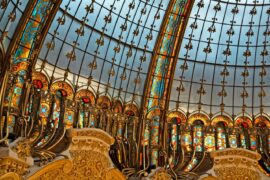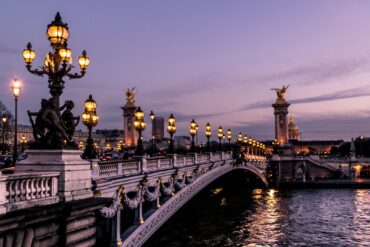Introduction to Les Invalides
Les Invalides is much more than a mere architectural monument in Paris. It is a place steeped in history and culture, drawing millions of visitors each year. As one of the most iconic structures in the French capital, it tells the fascinating story of France’s past. In this article, I invite you to explore this remarkable site with me and discover why it is a must-see during your visit to Paris.
Located in the 7th arrondissement, Les Invalides is easily recognizable by its majestic golden dome. This site is not only an architectural masterpiece but also home to museums, the tombs of war heroes, and much more. Whether you’re passionate about military history or simply looking for a rich cultural experience, Les Invalides has something for everyone.
This monument has also been the setting for many events that shaped the history of France. By visiting Les Invalides, you’ll have the chance to dive into the nation’s glorious past and understand the importance of this site in the development of French cultural heritage.
The Origins of Les Invalides
The story of Les Invalides dates back to the 17th century, during the reign of King Louis XIV. Faced with a growing number of wounded and disabled soldiers, the king decided to create a place to house those who had served France with dedication. In 1670, construction of Les Invalides began, with the primary goal of providing a haven for those who had sacrificed their health for the nation.
The project was entrusted to architect Libéral Bruant, who designed a building that was both functional and majestic. Les Invalides was inaugurated in 1676 and quickly became a model for similar institutions across Europe. At its peak, it could house up to 4,000 veterans, offering them accommodation, medical care, and even recreational activities to improve their quality of life.
This structure embodies the spirit of solidarity and gratitude toward soldiers that Louis XIV wished to promote. To this day, Les Invalides continues its original mission by housing the National Institution of Invalids, dedicated to veterans and civilians injured in the line of military duty.
The Architecture and Design of Les Invalides
The architecture of Les Invalides is a testament to the ingenuity and talent of 17th-century designers. The main building was created in a classical style, with elegant symmetry and ornamental details that reflect the grandeur of the era. The façades are adorned with columns and statues representing allegorical and military figures, emphasizing the site’s national significance.
The dome of the Église Saint-Louis-des-Invalides, also known as the Dôme des Invalides, is undoubtedly the most iconic architectural feature of the site. Designed by Jules Hardouin-Mansart, the dome is covered in gold leaf and rises majestically above the Paris skyline. Inside, the decoration is equally stunning, with frescoes and motifs that celebrate France’s military glory.
The entire complex of Les Invalides spans over 13 hectares and includes several interior courtyards, the most famous of which is the Cour d’Honneur. This grand courtyard is often used for military ceremonies and official events, further reinforcing the importance of Les Invalides in French public life.
Museums and Exhibitions at Les Invalides
Les Invalides houses several museums that allow visitors to explore France’s military and cultural history. The most renowned is the Musée de l’Armée, one of the largest military museums in the world. It features an impressive collection of weapons, armor, and military objects dating from Antiquity to the present day.
In addition to the Musée de l’Armée, the complex includes the Musée des Plans-Reliefs, which displays detailed scale models of historic fortified towns. These miniatures offer fascinating insight into military strategy and urban planning throughout history. For art and history lovers, the Musée de l’Ordre de la Libération showcases key figures and events from the French Resistance during World War II.
These museums are not just exhibition spaces—they are also centers for education and research. They regularly host lectures, workshops, and guided tours to help visitors gain deeper insight into the historical and cultural context of their collections. A visit to these museums is a rich experience that perfectly complements any exploration of Les Invalides.
Key Historical Events Linked to Les Invalides
Les Invalides has witnessed many significant historical events that have shaped both France and the world. One of the most famous is the return of Napoleon Bonaparte’s remains in 1840, now resting beneath the majestic Dôme des Invalides. This solemn ceremony drew massive crowds, a testament to Napoleon’s enduring legacy in French history.
Over the centuries, Les Invalides has also hosted numerous military ceremonies, commemorations, and parades that reinforced its status as a central site of French military life. During World War II, it served as a meeting point for Resistance forces, symbolizing the fight for France’s freedom and independence.
More recently, the site has been chosen for national tributes, including those honoring Charles de Gaulle and Jacques Chirac. These moments highlight Les Invalides’ role as a symbol of national unity and collective memory—a place where France pays homage to its heroes and reflects on its past.
The Role of Les Invalides in French Culture
Les Invalides holds a central place in French culture, thanks to both its architecture and its historical significance. It is not only a symbol of military pride but also a space where national memory is preserved and celebrated. As such, it plays a crucial role in educating future generations, offering them direct access to artifacts and stories from the past.
The site has also inspired countless artists, writers, and filmmakers seeking to capture the spirit of France. Many films and literary works have been influenced by Les Invalides, which often serves as a dramatic and historical backdrop. Its presence in popular culture reinforces its status as an unmissable monument.
Finally, Les Invalides is a place of gathering for Parisians and tourists alike, hosting cultural events and community activities. Concerts, temporary exhibitions, and festivals are regularly held in its gardens and halls, making Les Invalides a vibrant center of French cultural life.
Visiting Les Invalides: Practical Tips
If you’re planning to visit Les Invalides, a few practical tips can help you make the most of your experience. First, it’s best to dedicate an entire day to fully explore the site, as there is a lot to see and learn. Begin with the museums, taking your time to enjoy the diverse collections and any temporary exhibitions on display.
Be sure to visit the Dôme des Invalides, where Napoleon Bonaparte is buried. The interior architecture and decor are breathtaking, and it’s one of the highlights of the entire visit. To avoid large crowds, consider coming early in the morning or later in the afternoon.
Lastly, take time to stroll through the gardens and courtyards of Les Invalides. These peaceful spaces offer a moment of reflection and a chance to admire the building’s full grandeur.






